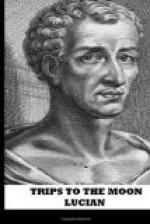Not able to bear any longer such melancholy spectacles, we took our leave of Nauplius, and returned to our ship. In a short time after we had a view, but confused and indistinct, of the Island of Dreams, which itself was not unlike a dream, for as we approached towards it, it seemed as it were to retire and fly from us. At last, however, we got up to it, and entered the harbour, which is called Hypnus, {136a} near the ivory gates, where there is a harbour dedicated to the cock. {136b} We landed late in the evening, and saw several dreams of various kinds. I propose, however, at present, to give you an account of the place itself, which nobody has ever written about, except Homer, whose description is very imperfect.
Round the island is a very thick wood; the trees are all tall poppies, or mandragorae, {136c} in which are a great number of bats; for these are the only birds they have here; there is likewise a river which they call Nyctiporus, {136d} and round the gates two fountains: the name of one is Negretos, {137a} and of the other Pannychia. {137b} The city has a high wall, of all the colours of the rainbow. It has not two gates, as Homer {137c} tells us, but four; two of which look upon the plain of Indolence, one made of iron, the other of brick; through these are said to pass all the dreams that are frightful, bloody, and melancholy; the other two, fronting the sea and harbour, one of horn, the other, which we came through, of ivory; on the right hand, as you enter the city, is the temple of Night, who, together with the cock, is the principal object of worship amongst them. This is near the harbour; on the left is the palace of Somnus, for he is their sovereign, and under him are two viceroys, Taraxion, {138a} the son of Mataeogenes, and Plutocles, {138b} the son of Phantasion. In the middle of the market-place stands a fountain, which they call Careotis, {138c} and two temples of Truth and Falsehood; there is an oracle here, at which Antiphon presides as high-priest; he is inventor of the dreams, an honourable employment, which Somnus bestowed upon him.




